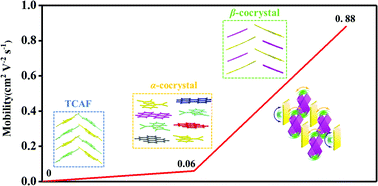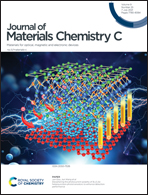Cocrystal engineering of molecular rearrangement: a “turn-on” approach for high-performance N-type organic semiconductors†
Abstract
Developing novel high-performance n-type semiconductors is of great importance for future organic electronics. Complicated synthesizing procedures of new electron deficient backbones or chemical modification to control the energy level and electron transport route limit their applications. Here, using PAH donor doping, we report that two polymorphs of TCAF based complexes act as efficient n-type semiconductors originating from inactive pristine material. These supramolecular structures possessed different donor–acceptor overlaps along the mixed π–π stacking direction with the same molar ratio of 1 : 1. Also the complete phase transition of the microcrystals on the substrate could happen under controllable solvent treatment. As a result, a large shift of electron mobility from 0.06 to 0.88 cm2 V−1 s−1 was observed, due to the phase change. Quantum calculations confirmed that the polymorphic structure containing better overlaps allowed larger transfer integrals than that with distorted overlaps. The charge transport properties of the binary supramolecular system are highly correlated with the molecular orientations. This cocrystal engineering approach of phase control provides us new insight towards high performance n-type organic semiconductor exploration.



 Please wait while we load your content...
Please wait while we load your content...